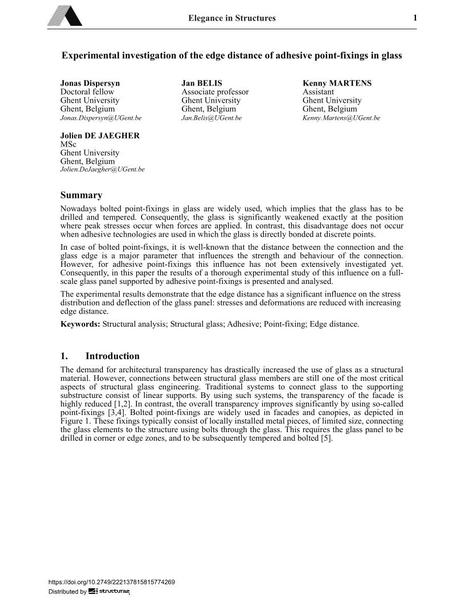Experimental investigation of the edge distance of adhesive point-fixings in glass

|
|
|||||||||||
Bibliografische Angaben
| Autor(en): |
Jonas Dispersyn
Jan Bells Kenny Martens Jolien De Jaegher |
||||
|---|---|---|---|---|---|
| Medium: | Tagungsbeitrag | ||||
| Sprache(n): | Englisch | ||||
| Tagung: | IABSE Conference: Elegance in structures, Nara, Japan, 13-15 May 2015 | ||||
| Veröffentlicht in: | IABSE Conference Nara 2015 | ||||
|
|||||
| Seite(n): | 134-135 | ||||
| Anzahl der Seiten (im PDF): | 8 | ||||
| Jahr: | 2015 | ||||
| DOI: | 10.2749/222137815815774269 | ||||
| Abstrakt: |
Nowadays bolted point-fixings in glass are widely used, which implies that the glass has to be drilled and tempered. Consequently, the glass is significantly weakened exactly at the position where peak stresses occur when forces are applied. In contrast, this disadvantage does not occur when adhesive technologies are used in which the glass is directly bonded at discrete points. In case of bolted point-fixings, it is well-known that the distance between the connection and the glass edge is a major parameter that influences the strength and behaviour of the connection. However, for adhesive point-fixings this influence has not been extensively investigated yet. Consequently, in this paper the results of a thorough experimental study of this influence on a full- scale glass panel supported by adhesive point-fixings is presented and analysed. The experimental results demonstrate that the edge distance has a significant influence on the stress distribution and deflection of the glass panel: stresses and deformations are reduced with increasing edge distance. |
||||
| Stichwörter: |
Schnittgrößenermittlung Randabstand
|
||||
